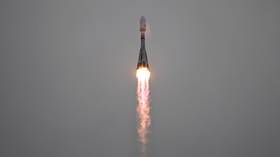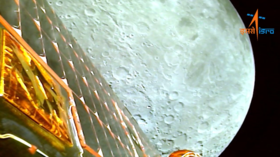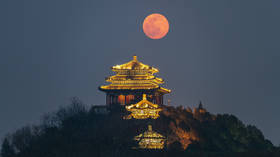
Luna-25 aims to land in an area believed to have water deposits – a prerequisite for permanent human settlement

The Soyuz-2.1b carrier rocket with the Fregat upper stage carrying the Luna-25 moon lander developed by S.A. Lavochkin Research and Production Association blasts off from the launchpad at the Vostochny cosmodrome in Amur Region, Russia. © Sputnik/Grigory Sysoev
Russia’s state space corporation, Roscosmos, reported on Friday that the Luna-25 Moon mission – the first since 1976 – separated from the upper stage ‘Frigate’ and is continuing its voyage to the Earth’s satellite. So far, all avionics have been functioning properly, with operators maintaining a stable connection with the spacecraft, Roscosmos added in its statement.
Blasting off from the Vostochny Cosmodrome in the far-eastern Amur Region on Friday morning, Luna-25 is expected to land on the Moon’s uncharted south pole between August 21 and 24.
Given the area’s rough terrain, the landing will not be straightforward – the spacecraft will first orbit the Moon at an altitude of 100 kilometers for up to a week. During this time, Luna-25 will be conducting trajectory measurements, with operators having to decide between three landing sites – the main one north of the Boguslavsky Crater and two reserve sites.
If everything goes according to plans, the mission will spend one year gathering samples on the surface.
Weighing 1.8 tons, the station carries 31 kilograms of scientific equipment and is fitted with a total of eight cameras, and a Lunar Robotic Arm.
The reason that Russia is attempting to land on the Moon’s less hospitable south pole rather than the equatorial region is no coincidence. Scientists believe that there are water ice deposits in the area where the Russian mission is expected to touch down. Moreover, the south pole is constantly lit by the Sun, meaning that solar panels can be placed there to generate energy for future missions.

Among Luna-25’s key objectives is performing a soft landing on the south pole – something other nations have failed to pull off so far. This aspect is important to ensure the success of future missions.
On top of that, the Russian station will drill for water – both to avoid the need to transport water from the Earth for future manned missions, as well as for conducting scientific studies. Water is believed to have arrived on the Moon by way of comets, so by analyzing it, scientists could “discover something new about the Moon’s history as well as the fundamental laws of the Universe,” Roscosmos’ Aleksandr Bloshenko explained.
Luna-25 will also be studying radiation on the Moon and lunar dust, with a view to using this knowledge to ensure the safety of future manned missions.
The head of the Moon program at the Russian Academy of Sciences, Lev Zeleny, noted that Russia and its competitors will be prospecting for rare-earth elements as well on the satellite.
Moscow’s ambitious plans
Luna-25 is part of the first stage of Russia’s Moon program. This initial stretch (known as ‘Sortie’) envisages the creation of a base module of a lunar station and the testing of a manned ‘Eagle’ spacecraft. As part of the stage, three more ‘Luna’ missions will be sent to the Moon in the coming ten years. Work on the new super-heavy Yenisei rocket should also begin during this stage.
The second stage will include the landing of Russian cosmonauts between 2025 and 2035. The crew is expected to spend two weeks on the Moon and lay the foundations for a permanent lunar base.
Finally, by 2040, Moscow hopes to complete the creation of a lunar base and two observatories.
Is Russia alone in its lunar quest?
Developing their own lunar programs in parallel are the US, China, and India.
NASA’s Artemis program is seeking to establish a human presence on the Moon as a stepping stone to the future exploration of Mars. Washington hopes to create its own lunar base by the end of this decade.

Boeing’s super-heavy SLS rocket is expected to be the main vehicle of the program. Its first manned trial is slated for November 2024.
China’s plans are equally ambitious, with Beijing expecting to set up a robotized base on the Moon by 2028 and to send a manned mission by 2030.
India has entered the lunar competition in recent years, with its Chandrayaan-3 lunar lander already orbiting the Moon and expected to land at around the same time as Russia’s Luna-25 at the end of this month. New Delhi is also eyeing the south pole.
In 2019, the mission’s previous iteration, Chandrayaan-2, strayed from the intended trajectory and crashed.
India is planning to send its next lunar mission in conjunction with Japan between 2026 and 2028.
Western media reactions to Russia’s mission
Commenting on the launch of Luna-25, the Wall Street Journal said it marks the start of a new space race – an allusion to the rivalry between the US and the Soviet Union in the 1950s and 60s.
Politico offered a similar assessment, quoting an expert as saying that if the mission succeeds, it will be a “massive technological and scientific achievement” for Moscow. The media outlet went on to suggest that by becoming the first nation to pull off a soft landing on the Moon’s south pole, Moscow would demonstrate to Beijing just how advanced its space technology is. This, according to Politico, would help strengthen Russia’s position in the two countries’ joint plans to establish an outpost on the Moon.
Similarly, France 24 claimed that Friday’s launch is a clear sign that “Russia is hoping to re-emerge as a major player in space exploration.” An expert quoted by the media outlet noted that Moscow’s Moon mission is meant to send a geopolitical signal as well.




